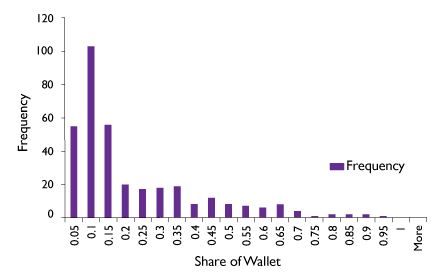Marketing Finance & Accounting Nov 1, 2012
Peeking Inside the Wallet
How much do consumers spend on their credit cards?
Recent advances in technology and marketing science have enabled companies to employ powerful new strategies to target their marketing efforts and maximize customer value.
But they still face a frustrating obstacle: they often have incomplete information about their customers’ behavior. They know what transactions their customers have engaged in with their company, but do not know about their customers’ transactions with competitors.
For example, a credit card company knows what each of its customers buys with its card, but it does not know about purchases made with other cards, cash, or checks. Yuxin Chen, professor of marketing at the Kellogg School of Management, and Joel H. Steckel, professor at New York University, have created a model that allows companies to combine information from other sources with the datasets they already have and gain useful insights into customer behavior.
For example, a credit card company might be considering a marketing campaign to entice customers to use its card more frequently to buy groceries. To effectively target such a campaign, it needs to know how often each customer uses the card to buy groceries and how much they spend, then determine the company’s “share of wallet”—the percentage of the customer’s total grocery spending that is done with that specific credit card.
“If the card has a low share of wallet and the targeted consumer goes to the grocery store very frequently, the promotion has a good chance of succeeding. On the other hand, if the card has a high share of wallet and the targeted consumer eats out most of the time and rarely goes grocery shopping, the promotion is likely to fail,” Chen and Steckel explain in a recent paper.
“If the card has a low share of wallet and the targeted consumer goes to the grocery store very frequently, the promotion has a good chance of succeeding.” — Chen and Steckel
Because companies do not see the whole picture, it is difficult for them to precisely target incentives and promotions to the customers who have the highest potential value. In their paper, Chen and Steckel report on how their new model helps companies fill in these information gaps.
The “Incomplete Information” Puzzle
The researchers obtained data on 350 consumers who collectively made 8,348 grocery purchases using a certain Visa card. They combined this data with information previously established by other research: the stochastic, or random, pattern of how frequently people shop for groceries.
“We know that the pattern of interpurchase times has to follow certain distributions on an aggregate level—that grocery purchases follow a certain distribution,” Chen explains. “We don’t really need to know the parameters of the distribution. The pattern is what we need to know, not the value.”
Interpurchase times “form the core of the incomplete information problem; i.e., missing purchase occasions in the data can render the observed interpurchase times very different from the underlying truth,” Chen and Steckel write in their paper.
From the combination of cardholder purchase data and knowledge of the pattern of interpurchase times, Chen and Steckel were able to create a mathematical model that deduced how consumers buy groceries using other means of purchase—other credit cards, cash, and checks. The share-of-wallet information they estimated on the 350 cardholders suggested that, overall, these customers used the cards involved in the study for about one out of five grocery purchases, but there was a wide range in the usage patterns (Figure 1). For example, one customer used the card for more than 90 percent of his purchases. This difference in potential customer value has specific implications for helping companies target their promotions.
Figure 1. Percentages of grocery purchases that 350 credit card customers made with the study’s fictitious “Princess Bank” VISA card.
“One person may spend $5,000 with you, but that person is already spending 90 percent of his money with you. Another person may spend $5,000 with you, but may spend $10,000 altogether,” Chen notes. “Without this method, you would see these two people in the same way, but now we see that the second person has a lot of upside potential for you. You may want to offer a promotion or incentive to the second person, not to the first person.”
Traditionally, he says, a company would simply look at the sum spent with it to decide who was valuable and who was not. The new model allows companies to disentangle category spending and share of wallet to provide a better picture of customer behavior.
According to Chen, many writers have cited the “80-20 rule,” meaning that 20 percent of customers contribute around 80 percent of most companies’ total revenue. However, his research revealed that the rule is closer to 80-59 at the category level for groceries, meaning that 59 percent of customers contribute 80 percent of revenue in the grocery category.
Broad Applicability
Chen has already applied a similar idea on behalf of other companies. For example, in consulting with a Chinese airline, he identified people who traveled by air frequently but who rarely flew on that specific airline. His findings enabled the airline to design incentives to entice those travelers to choose their airline more frequently.
The model might yield interesting results for other retailers, Chen and Steckel believe. “What fraction of books does a typical Amazon.com customer buy through Amazon?” they ask in their paper. “What is Home Depot’s [share of wallet] with respect to its customers?”
They anticipate that companies will be able to apply the model if they have a complete set of customer purchase data, if the product category is one in which purchase behavior is stationary over a relatively long period (for example, purchases of gasoline and telecommunications services are more predictable than purchases of homes and automobiles), and if the company knows the pattern of interpurchase times. The researchers’ next step will be to see if the model can deliver on its promise to help companies reliably increase the profitability of their customer bases.
Related reading on Kellogg Insight
When Memory Serves: Customers Better Remember Low Prices
Membership Has Its Punishments: Loyalty Programs Dissuade Firms from Pricing Products Competitively
Chen, Yuxin, and Joel H. Steckel. 2012. “Modeling Credit Card Share of Wallet: Solving the Incomplete Information Problem.” Journal of Marketing Research, 49(5): 655-669.



